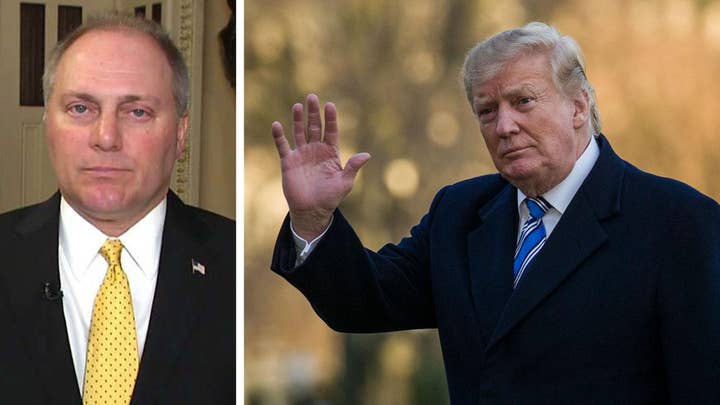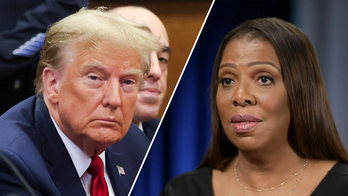Trump requests $8.6 billion for border wall in new budget proposal
Budget faces an uphill battle from Democrats in the House; chief congressional correspondent Mike Emanuel reports.
Certain things in Washington demand astute attention. Then there are things which serve as spectacular distractions.
President Trump released his budget request this week. Note we said a “budget request.” It’s up to Congress to decide if it should direct money toward the President’s priorities (unless of course, the chief executive declares a national emergency).
TRUMP RELEASES BUDGET SEEKING BILLIONS FOR BORDER WALL, WORK REQUIREMENTS FOR WELFARE PROGRAMS
Budgets are worth investing some time to cull through. A close reading of the budget helps one develop a sense of the policies and positions advocated by administrations. A budget is a wish list. An aspiration. But no one should interpret a budget as a raw, fiscal ledger.
First off, budgets aren’t binding. Congress doesn’t have to approve or reject a president’s budget. That said, some lawmakers from the party opposite of the President periodically try to engineer a vote on the budget request. This is an effort to weaponize a roll call vote against vulnerable lawmakers from across the aisle – and then guffaw that the President’s budget only received so many votes from his most-loyal supporters. White House Chief of Staff Mick Mulvaney executed such a maneuver with one of President Obama’s budgets when he served in the House as a Republican Congressman from South Carolina. Senate Minority Leader Chuck Schumer, D-N.Y., suggested the same about Mr. Trump’s budget earlier this week.
This is where budget requests devolve into classic, Inside the Beltway theatre. In addition to the President’s budget request, the House and Senate are supposed to adopt budgets to set broad spending parameters for the entire federal government for the new fiscal year. But these budgets are “resolutions” and are not signed into law.
This is why lawmakers from both sides attempt to mastermind a series of “gotcha” votes for the other side with the budget process. This is precisely why House Democrats may not even adopt a budget this year – to say nothing of the fact that Democrats may have trouble coming together to approve a budget blueprint.
Now, if you retain nothing else from the rest of this essay, remember the following: budgets are not the same as appropriations. Lawmakers and reporters sometimes mention a “budget” when they are actually discussing appropriations. This creates infinite confusion as the public tries to understand exactly what’s important in Washington. “Appropriations” refers to the 12 spending bills Congress must approve by October 1 each year – or face a government shutdown. So, Congress certainly won’t adopt President Trump’s budget. It’s doubtful the House and Senate will adopt a budget this year, either. But what lawmakers MUST do is approve the appropriations bills or spill into yet another government shutdown come fall.
Appropriations are actual live ammo. Appropriations are real money. Budgets, again, are simply sketches.
This brings us to a familiar calisthenics routine in the annual budgetary repertoire: When does a President’s proposal forecast that the budget will balance?
NIELSEN DECLARES MIGRATION CRISIS 'SPIRALING OUT OF CONTROL,' WARNS IT WILL GET 'EVEN WORSE'
President Trump’s budget for FY 2020 says the U.S. should be able to balance the books by 2034. We’ve heard similar assertions by both Republican and Democratic Presidents for more than 40 years. And it never works.
In February, 1981, President Reagan told Congress he’d balance the budget by the end of his first term, January 1985.
Didn’t happen.
Leon Panetta served as President Clinton’s Budget Director in the early 1990s. Panetta said that
Mr. Clinton was crafting a budget which would balance in a decade.
Didn’t happen.
Republicans controlled both bodies of Congress in the mid-1990s. Then House Speaker Newt Gingrich, R-Ga., crafted the so-called “Contract with America,” projecting a balanced budget by 2002. The government did manage to run surpluses for several years in the late 90s and early 2000s. But that all changed a few years later and budget deficits returned.
In February, 2007, President George W. Bush advocated for a balanced budget by 2012.
Didn’t happen.
In 2013, then House Speaker John Boehner, R-Ohio, and future Speaker Paul Ryan, R-Wis., pushed for a balanced budget by 2023. We’re still four years away from 2023. But there is no way the federal government can curb the current fiscal trajectory in such a short timeframe.
Moreover, Ryan became House Budget Committee chairman in 2011. Ryan’s stock in trade was balancing the budget down the road and slashing close to $6 trillion in spending. These efforts were known colloquially as the “Ryan Budget” and formally as “The Path to Prosperity.” Fellow Republicans perceived Ryan as a budget genius. Ryan’s fiscal doctrine helped fuel his political ascendency. Sen. Mitt Romney, R-Utah, tapped the Wisconsin Republican to be the GOP Vice Presidential nominee in 2012. Ryan claimed the Speaker’s gavel in 2015.
As for balancing the budget and cutting spending?
Didn’t happen.
So, the latest goal for a balanced budget is 2034.
“The theme of this budget is promises kept. Taxpayers first,” said Acting Budget Director Russ Vought on Fox. “From day one, this President has put forward spending reductions in his very first budget that were the most in history of any President.”
So, 2034?
Well, anything is possible. But outside budget experts have decried the Trump budget as stocked with gimmicks. Likely they can balance the budget by 2034? Or ever? Just look at the track record.
This is why scouring through some of the President’s annual budget is an exercise in futility.
But here’s something which does deserve some scrutiny in the document.
Lawmakers and presidential administrations have long dealt with fiscal phenomenon called OCO. It’s pronounced OH-koh. It’s short for Overseas Contingency Operations. There are 12 annual spending measures which fund the federal government. But residing off to the side of those 12 spending silos is OCO. It’s not an individual appropriations bill. OCO is real money which adds to the deficit. It’s a fund lawmakers use to cover military and “overseas” spending needs which they don’t tuck into the regular spending bills.
Members of both parties have long criticized “gimmicks” like OCO as a way to spend money “off budget.” A better way to say it would be “off appropriations.” That way, the actual spending number in the separate appropriations bills looks good. But Congressional leaders need to court the support from lawmakers who simultaneously want to cut money and expend resources on various federal projects. That’s where OCO comes in.
Moreover, OCO isn’t subject to “sequestration spending caps” imposed in 2011. To solve the 2011 debt limit crisis, Congress and the Obama Administration agreed to “sequestration,” a set of mandatory restrictions, capping the size of each of the 12 spending bills. Those ceilings remain in place. But the sequestration restrictions don’t apply to OCO.
At a briefing Monday, Vought told reporters that the administrations does “not request any OCO money, for the purchasing of or for the completion of the wall.”
True. But OCO is connected to the wall.
Senate Appropriations Committee Chairman Richard Shelby, R-Ala., has said repeatedly his panel will attempt to “backfill” money the administration is decanting from the spending bills to pay for the wall. But there’s a problem. The sequestration caps block Congress from just shoveling more money into the looted appropriations silos to make up the difference.
So how do you make up the difference?
Easy. Do the OCO-motion.
CLICK HERE TO GET THE FOX NEWS APP
Multiple Congressional sources note how the administration budget proposal entails $70.6 billion for defense OCO and $12.3 billion for non-defense OCO. The budget request maintains the sequestration caps. But in order to bolster defense, they added an OCO backfill. The easy place to make up the difference is OCO.
The backfill - whatever the means - is important. Lots of Republicans are for construction of the wall and the declaration of a national emergency. But they don’t want the administration to pilfer one of the spending silos and where money is directed to projects they support. That’s why the backfill is critical.
So, if you’re looking for things to count in the President’s budget, don’t pay heed to claims of balancing the budget by 2034. But do pay attention to OCO. It can be gimmicky. It’s not even a regular spending bill. But it is real money. And, OCO is key to understanding this year’s budget, the fight over the border wall and Mr. Trump’s national emergency declaration.






